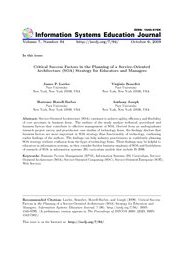Volume 7
Volume 7, Number 94 |
October 6, 2009 |
Abstract: Service-Oriented Architecture (SOA) continues to achieve agility, efficiency and flexibility of core processes in business firms. The authors of the study analyze technical, procedural and business factors that contribute to effective management of SOA. Derived from an undergraduate research project survey and practitioner case studies of technology firms, the findings disclose that business factors are more important in SOA strategy than functionality of technology, confirming earlier findings of the authors. The findings can help industry practitioners in confidently planning SOA strategy without confusion from the hype of technology firms. These findings may be helpful to educators in information systems, as they consider further business emphasis of SOA and fruitfulness of research of SOA in information systems (IS) curriculum models that include IS 2006.
Keywords: Business Process Management (BPM), Information Systems (IS) Curriculum, Service-Oriented Architecture (SOA), Service-Oriented Computing (SOC), Service-Oriented Enterprise (SOE), Web Services
Download this issue: ISEDJ.7(94).Lawler.pdf (Adobe PDF, 30 pages, 1374 K bytes)
Preview the contents: Lawler.j.txt (ASCII txt, 65 K bytes)
Recommended Citation: Lawler, Benedict, Howell-Barber, and Joseph (2009). Critical Success Factors in the Planning of a Service-Oriented Architecture (SOA) Strategy for Educators and Managers. Information Systems Education Journal, 7 (94). http://isedj.org/7/94/. ISSN: 1545-679X. (A preliminary version appears in The Proceedings of ISECON 2008: §2523. ISSN: 1542-7382.)
